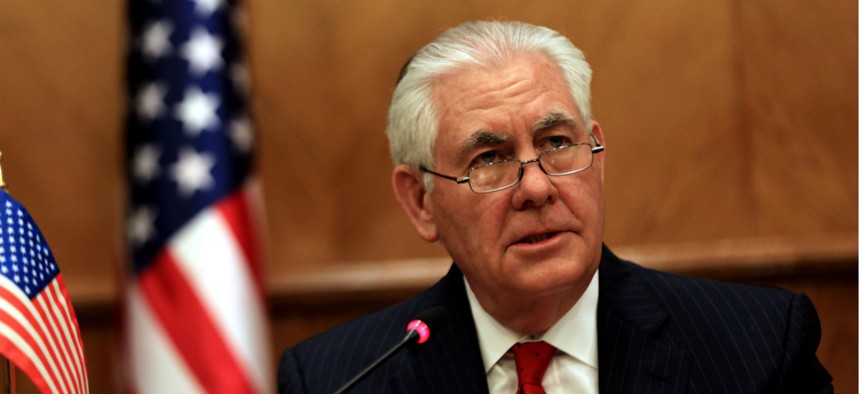
A hiring freeze under former Secretary of State Rex Tillerson is partly to blame. State Department
State Department Vacancies Are Delaying Embassy Construction
Planners also failed to account for inflation in cost calculations, GAO finds.
One probable effect of the hiring freeze imposed in 2017 by then-Secretary of State Rex Tillerson is that the State Department’s multi-year construction program to modernize and secure embassies and consulates is behind schedule.
Unexpected new cost requirements for annexes and a neglect of the impact of inflation also contributed to the delays in State’s Capital Security Construction Program, according to a Government Accountability Office report released on Oct. 25.
It zeroed in on State’s Bureau of Overseas Buildings Operations, which has a 20 percent vacancy rate—some 280 unfilled Foreign Service and Civil Service positions out of 1,415 (plus contractors)—as a possible obstacle.
“Although State has made progress in constructing more secure embassies,” planners “will not achieve the target of constructing 150 new embassies by 2018, a milestone that ....2005 cost-sharing was intended to facilitate,” the auditors found. And the construction program that since 1999 has received only one funding adjustment for inflation will not be getting another soon under current department policies.
Over the past two decades—since the 1998 terrorist bombings of U.S. embassies in Nairobi, Kenya, and Dar es Salaam, Tanzania—State’s approach to new facility building focused on enhanced security. But beginning in 2011, the Obama administration brought a shift based on complaints that the new embassies were “too fortress-like,” introducing the Excellence in Diplomatic Facilities Initiative to allow more-customized designs that eased access to localities.
Republican lawmakers, however, in hearings and a report faulted that approach as too expensive and “fancy,” at the expense of security.
From fiscal 1999 through 2017, State completed 77 new embassies and had 21 under construction, GAO noted. In fiscal 2017, it forecast a potential need for 72 additional embassies beyond those completed or under construction. The average construction time is about 36 months.
The present and future challenges, GAO continued, include rising workloads and issues with smooth contractor collaboration. “It is unclear if the [Overseas Buildings Operations] staffing is commensurate with its workload under the Excellence approach,” auditors wrote after reviewing budget documents, interviewing contracting officials and making four site visits.
Currently, the overseas building office “does not provide information on inflationary effects on [the capital program] or an estimated total capital investment or feasible time frames for the nearly 50 embassies identified for replacement beyond 2022,” GAO said. “Lack of such information may affect stakeholders’ ability to make informed budget decisions.”
And unless State performs a workforce analysis of the overseas building office, “it is unclear whether OBO’s staffing is commensurate with its workload needs,” GAO cautioned. “OBO maintains that its office overseeing project design reviews is understaffed, adversely affecting some of its critical functions. Contractors also expressed concerns about the quality of design reviews, which may be affected by a staffing shortage and the use of temporary contractors.”
GAO also faulted State for “lack of reliable data on the number of staff moved into the new embassies.”
GAO recommended that State provide information on the estimated effects of inflation on planned projects as well as an analysis of estimated total costs and timeframes to complete the capital construction program. Planners should also conduct the workforce analysis of the overseas buildings bureau and launch a pilot program on formal partnering with qualified contractors to avoid tensions, the watchdog said.
State Department officials agreed with the recommendations.
The report, which contains color photos of existing overseas facilities and artists’ renderings of future installations, includes cost-analysis case studies of projects in such locations as Pristina, Kosovo; Port Moresby, Papua New Guinea; Beirut, Lebanon; and Hyderabad, India.







